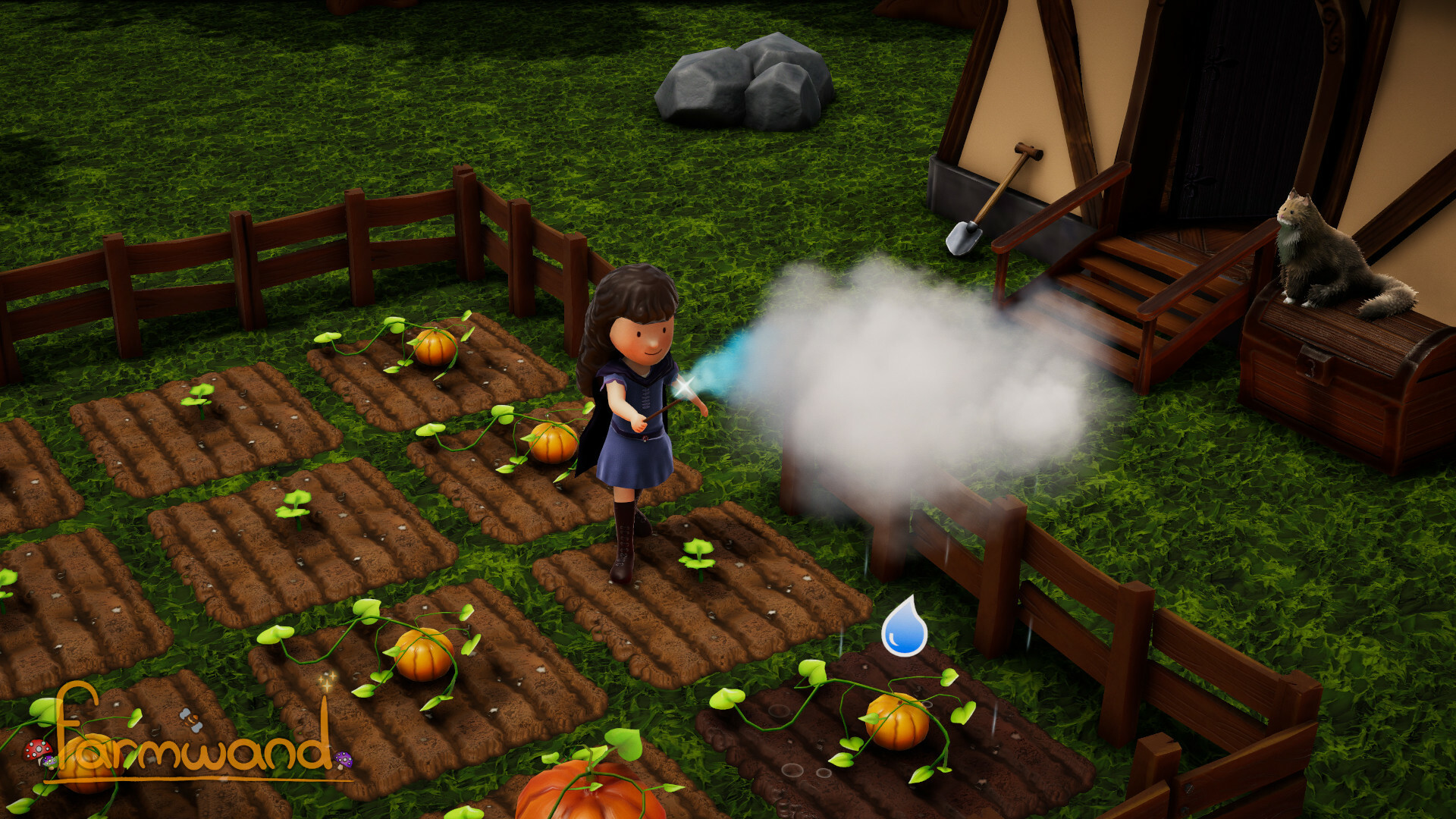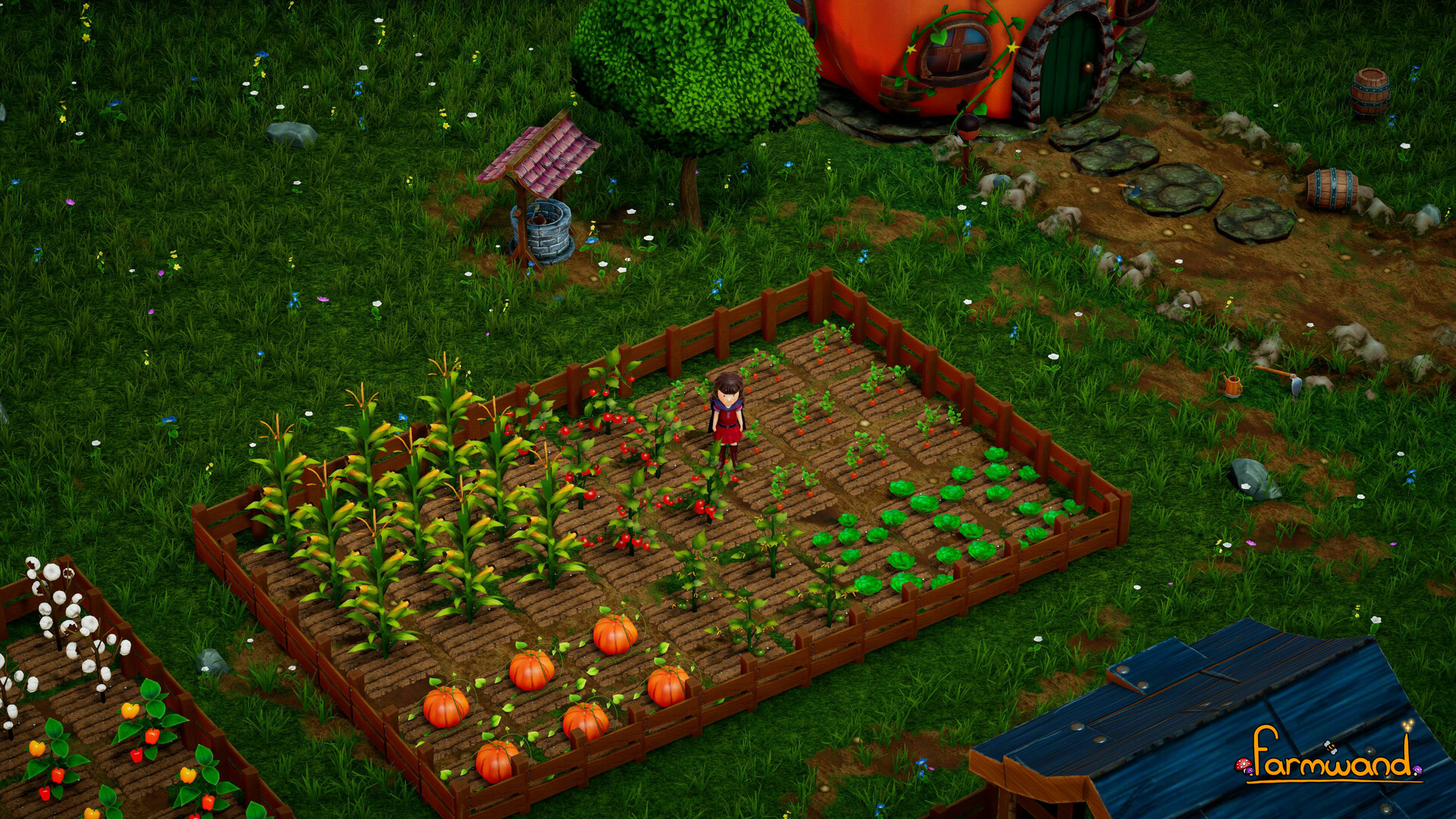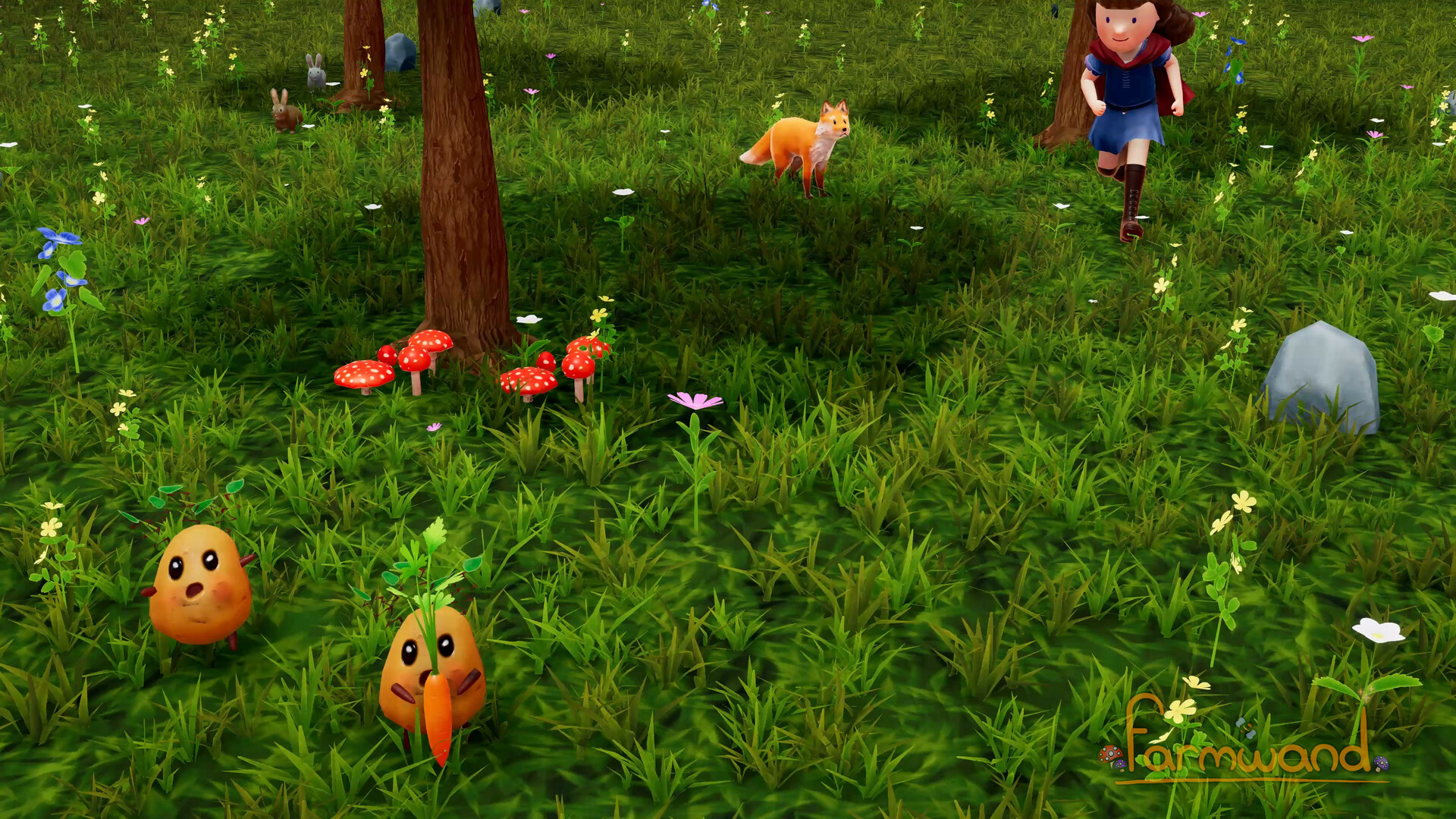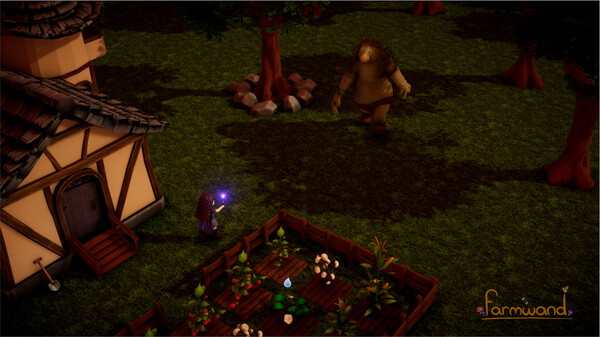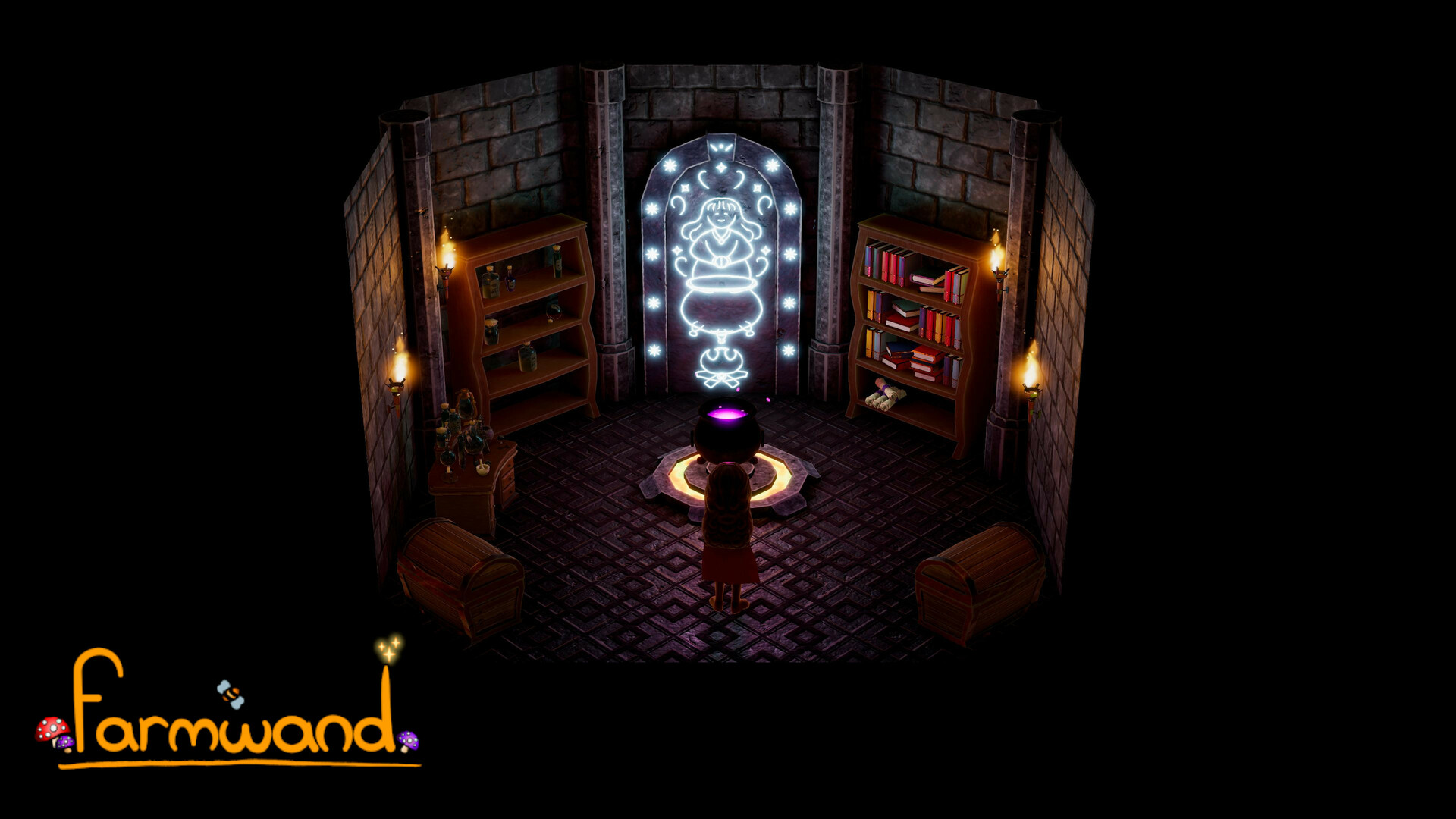
Fresh out of the Southern Wizarding Academy and finally ready to face the world, you build your own wand, prepare your robes and reach the land where you’ll settle. Some potatoes here, a few mushrooms there…some chickens maybe? A cat for sure...the necessary ingredients for a potion or two and the broom of course… it’s time to make this new land your home!
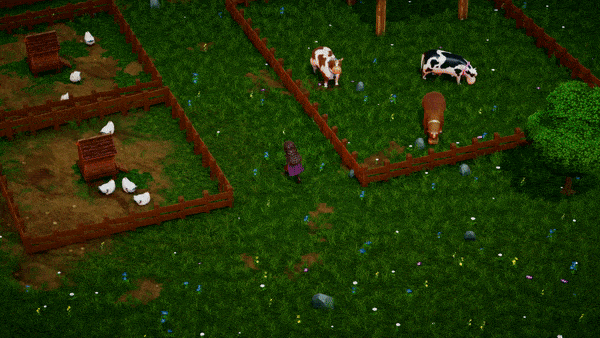
The world of Farmwand is a rich land inspired by classical fairy tales full of enchanted forests, potions brewing under the moonlight, towns buzzing with merchants and travelers, magical creatures both friendly and hostile, as well as mysteries to uncover under every rock and around every corner.
A living world where most characters have stories to tell and your actions can change the way people interact with you.
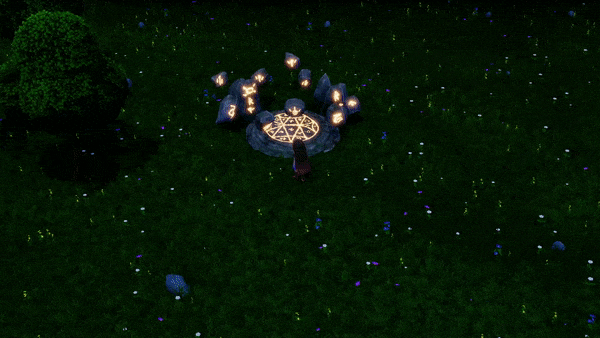

- Art Style : We are going for a unique children's storybook graphics style with original designs for all the creatures in the game.
- Farming : Dozens of crops, flowers and animals to harvest, garden and care for, with a deep and rewarding magically enhanced farming system that allows for endless surprises.
- Pets : There are all sorts of animals and magical creatures that can be kept as companions in our game. They can be trained, they can be fed, they can wear cute outfits and, of course, they can be hugged and petted!
- Characters & Relationships : All sorts of creatures & characters, magical and non-magical to interact with. Build friendships, rivalries, fall in love and be an ally or foe of both individuals and factions that you cross paths with during your adventure. Tons of characters are ready to meet you, all with their own stories, wants and needs.
- Customization : Both your character, your home and most of the accessories and items can be customized to your liking, so you can be who you wanna be.
- Magic : Dozens of spells and potions to discover and master over the course of your adventure, to use in inventive ways to solve puzzles, help (or annoy) the people in town and even mix them for unexpected results.
- Combat : The further away you get from home, the more dangerous and wild that the land will become. Grab your wand and some potions, make use of all your wits for there are foes in every corner, and with our real-time magical-based combat you have to be ready to face them all!
- Exploration : The world of Farmwand is vast and full of things to do. From mini-games all over town, special events and holidays, enchanted forests and dark caves and dungeons, you can see it all. If your destination is too far away, fly on your very own, customizable broom…but careful! They need to rest too!
- Crafting & Trading : Cut down some trees, mine, forage and gather resources to build new furniture, more efficient tools, powerful potions and so much more. Maybe bring them to the market, get a good bargain!
- A Deep Lore : A living world with its own culture, traditions, festivals and history to explore and take part of as the newest resident in town. Every faction and creature has more to them than it seems at first glance, and the most rewarding secrets await for the most curious of explorers!
- Co-op : Want some help and company in the new place ? Join a friend to water your crops or fight monsters together in local co-op.
- Original Soundtrack : The soundtrack of our game has been composed by Sean McRoberts, it currently has all the core tracks and we plan on expanding it!
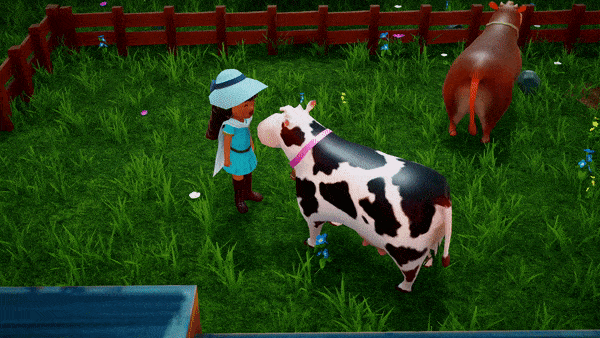
Giving Farmwand a bit of a workout
Over the past week or so we have been redesigning completely the way that crops work (internally) in Farmwand. This was a task we were not necessarily looking forward to since our previous system worked quite well, but we had two very important reasons for the revamp.
First, we are already implementing the whole save/load mechanics of Farmwand. We are quickly entering the alpha stage and the ability to save/load the game is a must, even if just for testing more complex scenes.
When you save a game, you are only storing information. Little numbers, texts, true/false statements, etc. That beautiful farm you made gets turned into a list of values and then, when you load, those values are read so the game can "re-plant" the farm matching exactly the recipe contained in your save file. In our previous system each plot of land was its own self-contained thing. This made coding for it easy but saving the game...not so much. That level of "independence" between each crop made organizing them in the save file kind of messy.
The second reason (also super important) was performance. While Unity and our PCs can handle very large amounts of crops without issues on our old crop system, we still plan to release the game for more limited and slower devices like some non-gaming laptops and eventually the Nintendo Switch (fingers crossed!). We want Farmwand to have a great port, where the main change is the screen size and not the quality or performance of the game. And while we had our discussions about how big of a farm is too big, by checking on other titles actual sizes for their farms we decided to run a few stress tests on older and newer devices.

So far so good, almost 90FPS, but still not good enough. Those FPS will drop after adding the landscapes, the towns, the animals and decorations. We needed a bit more margin if we want to be able to hit that 30FPS spot on lower end devices without issues.
Enter version 2 of our system. A full rewrite that turned all of our crops from "objects" into simple values within a table and now handles the processing of those values and their displaying as beautiful crops through the power of multi-threading, that is, using every little bit of processing power available on your device.
The math was scary, setting up all the data to work as efficiently as possible and finding a Unity version where everything worked without errors involved a healthy dose of hair pulling and more than a spoonful of programmer's tears but in the end, we managed to make it all work. And the results speak for themselves.

Our field went from 1024 (32x32) crops in our early stress test to 3000+(we've gone as far as 6000+) with version 2. There are still some more tests to be done, but with a field more than 3 times bigger and almost a 300% performance boost, we think we are on the right track :D
But what is left to do? We are taking out some of the third-party assets we've been using for foliage, terrains and other world-related stuff and replacing them with our in-house tools. This will allow the game to run much better in smaller consoles and devices and, hopefully, with enough power to spare so that the graphical quality does not get impacted negatively (no one likes a bad port where you get 10% of the game's visuals running at 20% of the speed).
A lot of work lies ahead, but once again, things are on the right track.
So, thank you for coming to our Ted talk, and until next time!
Hello Saeges!
Over the past week or so we have been redesigning completely the way that crops work (internally) in Farmwand. This was a task we were not necessarily looking forward to since our previous system worked quite well, but we had two very important reasons for the revamp.
First, we are already implementing the whole save/load mechanics of Farmwand. We are quickly entering the alpha stage and the ability to save/load the game is a must, even if just for testing more complex scenes.
When you save a game, you are only storing information. Little numbers, texts, true/false statements, etc. That beautiful farm you made gets turned into a list of values and then, when you load, those values are read so the game can "re-plant" the farm matching exactly the recipe contained in your save file. In our previous system each plot of land was its own self-contained thing. This made coding for it easy but saving the game...not so much. That level of "independence" between each crop made organizing them in the save file kind of messy.
The second reason (also super important) was performance. While Unity and our PCs can handle very large amounts of crops without issues on our old crop system, we still plan to release the game for more limited and slower devices like some non-gaming laptops and eventually the Nintendo Switch (fingers crossed!). We want Farmwand to have a great port, where the main change is the screen size and not the quality or performance of the game. And while we had our discussions about how big of a farm is too big, by checking on other titles actual sizes for their farms we decided to run a few stress tests on older and newer devices.

So far so good, almost 90FPS, but still not good enough. Those FPS will drop after adding the landscapes, the towns, the animals and decorations. We needed a bit more margin if we want to be able to hit that 30FPS spot on lower end devices without issues.
Enter version 2 of our system. A full rewrite that turned all of our crops from "objects" into simple values within a table and now handles the processing of those values and their displaying as beautiful crops through the power of multi-threading, that is, using every little bit of processing power available on your device.
The math was scary, setting up all the data to work as efficiently as possible and finding a Unity version where everything worked without errors involved a healthy dose of hair pulling and more than a spoonful of programmer's tears but in the end, we managed to make it all work. And the results speak for themselves.

Our field went from 1024 (32x32) crops in our early stress test to 3000+(we've gone as far as 6000+) with version 2. There are still some more tests to be done, but with a field more than 3 times bigger and almost a 300% performance boost, we think we are on the right track :D
But what is left to do? We are taking out some of the third-party assets we've been using for foliage, terrains and other world-related stuff and replacing them with our in-house tools. This will allow the game to run much better in smaller consoles and devices and, hopefully, with enough power to spare so that the graphical quality does not get impacted negatively (no one likes a bad port where you get 10% of the game's visuals running at 20% of the speed).
A lot of work lies ahead, but once again, things are on the right track.
So, thank you for coming to our Ted talk, and until next time!
[ 2023-08-07 18:39:01 CET ] [Original Post]
Minimum Setup
- OS: Ubuntu 16
- Processor: Intel Core i5. 6th generationMemory: 4 GB RAM
- Memory: 4 GB RAM
- Graphics: Nvidia GeForce 940MXAdditional Notes: This is a game in development and as such. requirements will change over time before the release.
Recommended Setup
- OS: Ubuntu 16
- Processor: Intel Core i7. 7700HQMemory: 16 GB RAM
- Graphics: NVidia GeForce GTX1060Additional Notes: This is a game in development and as such. requirements will change over time before the release.
GAMEBILLET
[ 6583 ]
GAMERSGATE
[ 4105 ]
MacGamestore
[ 6065 ]
FANATICAL BUNDLES
HUMBLE BUNDLES
by buying games/dlcs from affiliate links you are supporting tuxDB

